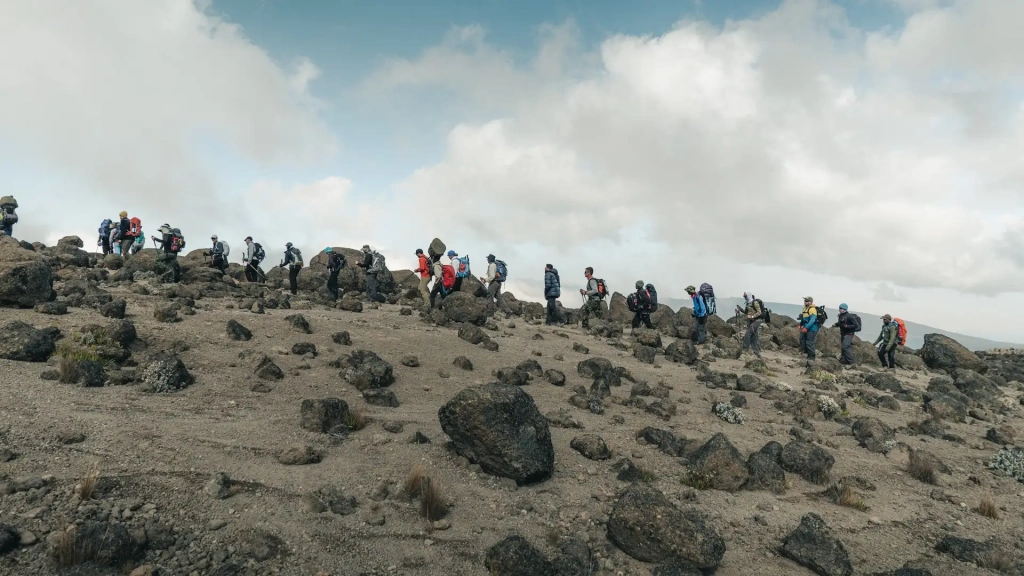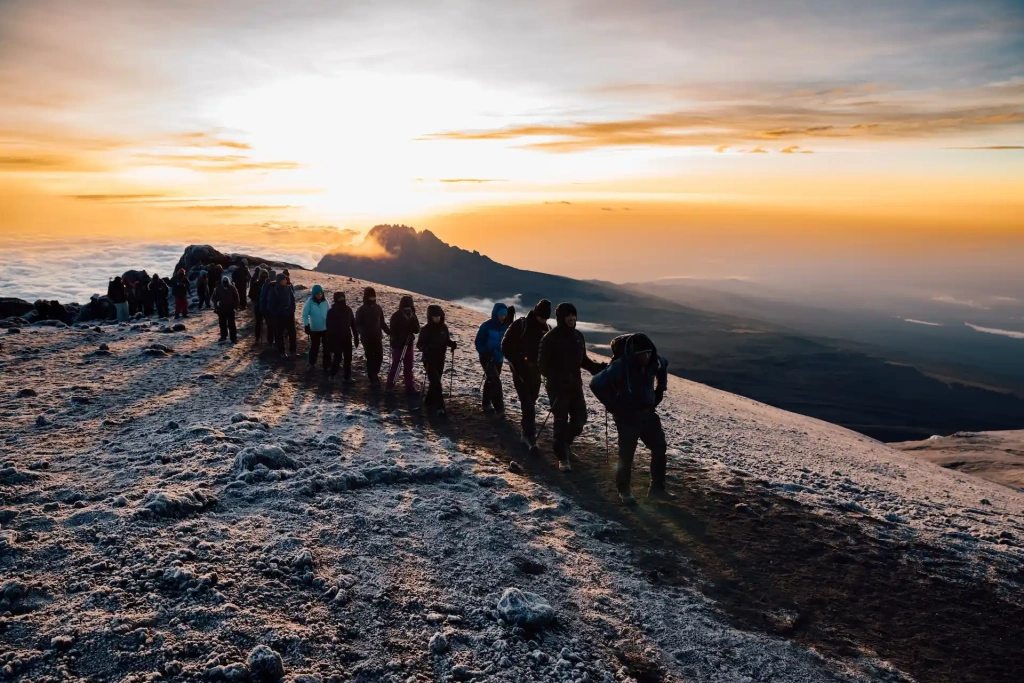Climbing Kilimanjaro is an exciting adventure, but the extreme altitude of 5,895 meters (19,341 feet) poses a risk of altitude sickness for climbers. To prevent it and help the body acclimatize, many use a medication called Diamox. In this Altezza Travel article, we explain what it is, how it works, the optimal dosage, and possible side effects.
At high altitudes, the air becomes thinner, with significantly less oxygen compared to sea level, which can lead to hypoxia (oxygen deficiency). Some climbers may experience slight oxygen deprivation as low as 2,000 meters (6,562 feet), although it is more commonly felt above 3,000 meters (9,843 feet). At such altitudes, the U.S. Centers for Disease Control and Prevention (CDC) notes that oxygen levels drop to approximately 69%, and blood oxygen saturation ranges from 88% to 91%. And this doesn’t always happen gradually.
One of Kilimanjaro’s most popular routes, Lemosho, starts at 3,500 meters (11,483 feet), after a vehicle transfer to the first camp. This means climbers may begin to feel the effects of oxygen deficiency just hours into the expedition.
In most cases, the human body can adapt to altitudes of around 4,000 meters (13,123 feet), adjusting its respiratory function to compensate for lower oxygen levels. Beyond that, however, it needs support. This includes slowing the ascent pace, taking frequent breaks, staying well-hydrated, and carefully monitoring well-being. Diamox (also known as Diacarb or acetazolamide) is often used to assist with acclimatization and prevent altitude sickness.
What is Diamox, and how does it work?
Diamox is the brand name for acetazolamide, a drug originally developed as a diuretic but widely known for its ability to prevent or alleviate altitude sickness symptoms such as headaches, nausea, dizziness, and fatigue — all common as you gain altitude. Diamox accelerates the body’s adaptation to reduced oxygen levels.
The medication slightly inhibits enzymes that combine carbon dioxide with water during respiration. This reduces the formation of carbonic acid in the body, helping to conserve oxygen and balance the body's pH. As a result, climbers breathe more deeply and frequently, allowing more oxygen to enter the bloodstream.
Diamox also helps with another common altitude-related issue — disrupted sleep. Many climbers experience irregular breathing during the night, which is a normal phenomenon at high elevations. Diamox helps regulate breathing, improving sleep quality and allowing the body to recover more effectively.
Keep in mind that acetazolamide is a diuretic, so frequent urination during the climb is a normal side effect. This is also due to the increased fluid intake — hikers are advised to drink at least four liters (1 gallon) of water per day.

Diamox effectiveness: studies and recommendations
Taking Diamox preventively reduces the risk of altitude sickness symptoms by about 48% compared to a placebo. This conclusion was made by the International Society of Travel Medicine, with research results published on the U.S. National Library of Medicine website. High doses are not necessary — 250 mg per day is almost as effective as higher amounts.
International health and travel organizations provide clear guidelines regarding acetazolamide. For example, the Wilderness Medical Society, a leading authority on altitude medicine, strongly recommends considering Diamox for preventing altitude sickness. The CDC also notes that trekking routes such as those to Everest Base Camp or the summit of Kilimanjaro carry a 30–40% risk of altitude sickness. Diamox can make the climb safer and more enjoyable.
That said, while studies confirm the medication’s effectiveness, it does not offer 100% protection. A field study on Kilimanjaro, led by Stuart J. Jackson from the University of Edinburgh, found that the preventive use of Diamox was almost ineffective during rapid ascents without adequate acclimatization time. That's why Altezza recommends choosing an itinerary of at least seven days and following guide instructions, especially regarding hydration and ascent pace. These are the keys to a successful summit.
When to take Diamox for altitude sickness?
The standard prevention protocol is to begin taking Diamox one day before the ascent and continue throughout the expedition. The recommended adult dosage is 125 mg twice a day (morning and evening). This dosage offers the best balance of effectiveness and minimal side effects.
You can also start taking Diamox on the day of the climb or after symptoms appear — but in the latter case, it's already treatment, not prevention. International organizations mentioned above strongly recommend starting early for preventive use.
Side effects and contraindications of Diamox
At preventive doses, Diamox’s side effects are generally mild. The most common are increased urination and tingling or mild numbness in the fingers. These sensations are uncomfortable but harmless and usually disappear after stopping the medication.
Other possible side effects include mild digestive upset (such as nausea or loss of appetite), dizziness, altered taste sensations, and, in rare cases, ringing in the ears or congestion. Fatigue, drowsiness, or a boost in energy are also considered normal reactions.
Special care should be taken in cases of allergies or individual intolerance. If you’ve ever had an allergic reaction to sulfonamides, Diamox is contraindicated. In uncertain situations, or if pregnant or planning pregnancy, consult a doctor.
Diamox should also be avoided by people with chronic conditions, such as kidney, liver, or adrenal gland disease, or obstructive pulmonary disease. However, it is generally safe for healthy individuals.
Alternatives to Diamox
Some climbers and guides use other medications to prevent or treat altitude sickness. Alternatives include:
- Ibuprofen and other NSAIDs: Recent studies show that regular ibuprofen can reduce altitude headaches and other symptoms. Still, it’s less effective than Diamox and usually recommended only if Diamox is contraindicated.
- Ginkgo biloba: This herbal extract was once thought to help prevent altitude sickness. However, studies have shown mixed results. Research by the University Health Sciences Research Foundation in Colombia found that it was only effective when used in combination with Diamox. Today, international health organizations do not recommend ginkgo due to unreliable data.
- Oxygen and hypoxic training: Some climbers undergo hypoxic training before their trip or use bottled oxygen at altitude. Pre-acclimatization involves simulating low-oxygen conditions (e.g., cardio training with special masks), but this is typically used by professional mountaineers preparing for much higher peaks. For Kilimanjaro, it’s better to focus on physical fitness and, if possible, do a short trek at moderate altitude a month before your trip.
- Bottled oxygen is commonly used on Kilimanjaro. Altezza Travel maintains a stock of around 500 oxygen systems, but these are used only in cases of severe symptoms of altitude sickness, not for prevention. While supplemental oxygen can help alleviate a climber’s condition, continuous use can hinder the body’s natural acclimatization process.
- Dexamethasone: An effective treatment for altitude sickness, but it doesn’t speed up acclimatization. It works by reducing inflammation and is primarily used in emergency situations or during rapid ascents without prior preparation, such as rescue operations.
In summary, Diamox is a proven medication for the prevention and treatment of altitude sickness, with its effectiveness confirmed by scientific studies, including those conducted in the context of climbing Mount Kilimanjaro. The drug accelerates the body’s acclimatization to high altitude and significantly reduces the risk of developing acute symptoms of altitude sickness. Combined with other acclimatization strategies for Kilimanjaro, Diamox can make the journey to the “Roof of Africa” much more comfortable and safe.
Diamox on Kilimanjaro: FAQ and quick facts
Does Diamox really help with altitude sickness?
Yes — scientific studies, including field tests in high-altitude environments, confirm it. Diamox reduces the risk of altitude sickness symptoms by 48%.
At what altitude should you take Diamox?
Mild symptoms may appear above 2,000 meters (6,562 feet), but typically occur from 3,000 meters (9,850 feet) and higher. The body may adapt up to 4,000 meters (13,100 feet), but it depends on individual fitness and ascent speed. In general, Diamox is recommended for climbs above 2,500–3,000 meters (8,200–9,800 feet).
Do you need to take Diamox when climbing Kilimanjaro?
It’s recommended, though not mandatory. International medical organizations strongly advise using Diamox for altitude sickness prevention on Kilimanjaro. Start one day before the climb and continue until the descent. Dosage: 125 mg twice a day. Always review the contraindications before use.
All content on Altezza Travel is created with expert insights and thorough research, in line with our Editorial Policy.
Want to know more about Tanzania adventures?
Get in touch with our team! We've explored all the top destinations across Tanzania. Our Kilimanjaro-based adventure consultants are ready to share tips and help you plan your unforgettable journey.



















